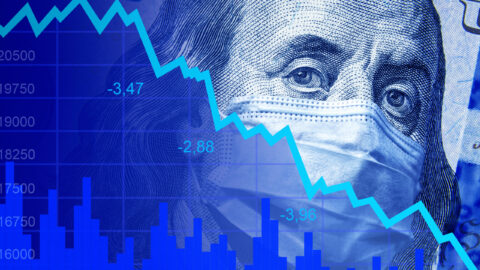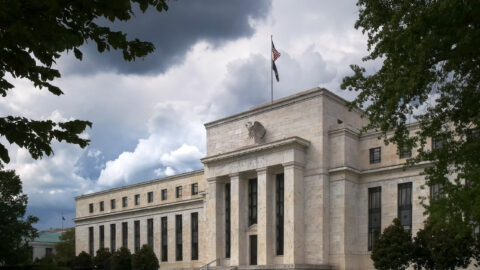With the pandemic and the war in Ukraine, the global economy has been confronted with two stagflationary events in just two years. Both are a source of great uncertainty.
Upside risks to inflation have increased
The increased inflation was caused by external shocks (pandemic, war in Ukraine). However, the interplay of particularly loose monetary and fiscal policies is likely to have intensified price pressures. Inflation rates have been surprisingly high and rising for quite some time. The key question is whether high inflation leads to permanently higher inflation expectations or whether the significantly higher price level leads to a reduction in demand, which keeps inflation expectations low.
The downside risks to economic growth have increased not only due to high inflation, because it reduces purchasing power and sentiment. There are also three other risk factors:
The lockdown measures in China
Zero tolerance policies toward new infections have led to strict lockdown measures. This has caused a contraction in retail sales and industrial production in March and a slump in purchasing managers’ indices for April (NBS Composite PMI in April: 42.7, Caixin Composite PMI: 37.2). A contraction of GDP in Q2 has become more likely. One uncertainty is the extent to which global supply chains will be affected.
The risk of import restrictions on energy from Russia
According to the EU Commission, a sixth sanctions package could include an import ban on Russian crude oil after a transition period of six months. Even if crude oil supplies can still be guaranteed, future measures could be even harsher. The recent G7 statement fits in with this: leaders will commit to reducing dependence on Russian energy, including by halting or banning imports of Russian oil. The G7 want to ensure that this happens in a timely and orderly manner, and in a way that gives the world time to secure an alternative supply.
Possibly overly restrictive monetary policies
More and more central banks are accelerating the exit from ultra-expansionary monetary policy stances. Even the dovish central banks such as the Riksbank (0.25%) and the Reserve Bank of Australia (0.35%) have raised key rates much earlier than originally expected. Pressure on the ECB to raise key rates has increased. Three hikes are now realistic for the deposit rate this year, from -0.5% to +0.25%. The market price is at 0.33%. The Bank of England has already raised the key interest rate four times in a row to a total of 1%, although it expects only slight economic growth until 2024.
As expected, the US central bank has accelerated the exit from its ultra-expansive monetary policy. While key interest rates are being raised quickly and sharply, the central bank balance sheet is being reduced. The range for the key interest rate was raised by 0.5 percentage points to 0.75% – 1%. At the press conference, Chairman Powell said that there was widespread agreement in the Committee that further hikes of 50 basis points should be on the table at the next meetings. The gives two reasons for the quick and rapid exit.
1) High inflation rates. Inflation is expected to fall in April (US CPI: 0.2% pm / 8.1% pa after 1.2% pm / 8.5% in March), but inflation is broad-based, i.e. many inflation components are showing above-average increases.
2) Tight labor market. The unemployment rate is low (April: 3.6%, unchanged from March), job openings have reached a record high of 11.5 million, and the labor cost index grew by 4.5% pa in the first quarter.
In principle, there are three scenarios. The determining factor is the high uncertainty about the difference between actual GDP and potential (the output gap).
| Scenario 1: If GDP is only moderately above potential, central banks can manage a soft landing of the economy in a favorable scenario. In this case, long-term inflation expectations would remain low. However, there are two unfavorable recession scenarios. |
| Scenario 2: When GDP is well above potential for an extended period of time, the likelihood of a switch to sustained high inflation expectations increases (overheating). The central bank is “behind the curve.” In this case, central bank policy would have to become very restrictive, i.e., intentionally create a recession (high unemployment) to get inflation under control. |
| Scenario 3: The exit from expansionary monetary policy is too fast. Central banks react to external price shocks, cannot influence inflation rates in the short run, but affect the economy so much that a recession is triggered. |
To summarize
This environment has led to a tightening of the financial environment. Prices of most asset classes have fallen since the beginning of the year. Uncertainty is high because the factors influencing the key indicators inflation, growth and monetary policy cannot be well estimated. No claim to completeness: output gap, neutral interest rate, inflation expectations, commodity prices, bottlenecks, pandemic, central bank behavior, geopolitics. Not even the current high inflation can be explained to full satisfaction. Once again, the inadequacies of the economic models become apparent.
The favorable base scenario is for a soft landing for the economy. However, the risks are elevated. In addition, it will be much more difficult for the Fed and other central banks to respond to a financial crisis with a loose monetary policy in the future. At least as long as inflation remains high.
Explanations of technical terms on investment and securities can be found in our Fund Glossary: Fund Glossary (erste-am.at)
Legal note:
Prognoses are no reliable indicator for future performance.
Legal disclaimer
This document is an advertisement. Unless indicated otherwise, source: Erste Asset Management GmbH. The language of communication of the sales offices is German and the languages of communication of the Management Company also include English.
The prospectus for UCITS funds (including any amendments) is prepared and published in accordance with the provisions of the InvFG 2011 as amended. Information for Investors pursuant to § 21 AIFMG is prepared for the alternative investment funds (AIF) administered by Erste Asset Management GmbH pursuant to the provisions of the AIFMG in conjunction with the InvFG 2011.
The currently valid versions of the prospectus, the Information for Investors pursuant to § 21 AIFMG, and the key information document can be found on the website www.erste-am.com under “Mandatory publications” and can be obtained free of charge by interested investors at the offices of the Management Company and at the offices of the depositary bank. The exact date of the most recent publication of the prospectus, the languages in which the fund prospectus or the Information for Investors pursuant to Art 21 AIFMG and the key information document are available, and any other locations where the documents can be obtained are indicated on the website www.erste-am.com. A summary of the investor rights is available in German and English on the website www.erste-am.com/investor-rights and can also be obtained from the Management Company.
The Management Company can decide to suspend the provisions it has taken for the sale of unit certificates in other countries in accordance with the regulatory requirements.
Note: You are about to purchase a product that may be difficult to understand. We recommend that you read the indicated fund documents before making an investment decision. In addition to the locations listed above, you can obtain these documents free of charge at the offices of the referring Sparkassen bank and the offices of Erste Bank der oesterreichischen Sparkassen AG. You can also access these documents electronically at www.erste-am.com.
Our analyses and conclusions are general in nature and do not take into account the individual characteristics of our investors in terms of earnings, taxation, experience and knowledge, investment objective, financial position, capacity for loss, and risk tolerance. Past performance is not a reliable indicator of the future performance of a fund.
Please note: Investments in securities entail risks in addition to the opportunities presented here. The value of units and their earnings can rise and fall. Changes in exchange rates can also have a positive or negative effect on the value of an investment. For this reason, you may receive less than your originally invested amount when you redeem your units. Persons who are interested in purchasing units in investment funds are advised to read the current fund prospectus(es) and the Information for Investors pursuant to § 21 AIFMG, especially the risk notices they contain, before making an investment decision. If the fund currency is different than the investor’s home currency, changes in the relevant exchange rate can positively or negatively influence the value of the investment and the amount of the costs associated with the fund in the home currency.
We are not permitted to directly or indirectly offer, sell, transfer, or deliver this financial product to natural or legal persons whose place of residence or domicile is located in a country where this is legally prohibited. In this case, we may not provide any product information, either.
Please consult the corresponding information in the fund prospectus and the Information for Investors pursuant to § 21 AIFMG for restrictions on the sale of the fund to American or Russian citizens.
It is expressly noted that this communication does not provide any investment recommendations, but only expresses our current market assessment. Thus, this communication is not a substitute for investment advice.
This document does not represent a sales activity of the Management Company and therefore may not be construed as an offer for the purchase or sale of financial or investment instruments.
Erste Asset Management GmbH is affiliated with the Erste Bank and austrian Sparkassen banks.
Please also read the “Information about us and our securities services” published by your bank.


